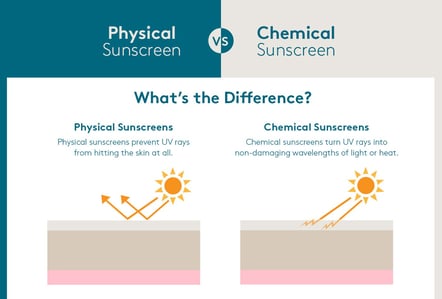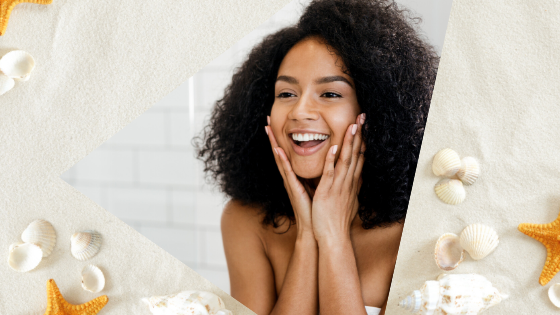Knowing your sunscreens and choosing the right one for your skin is paramount for any kind of fun in the sun this summer. Don’t get us wrong, though – sunscreen should be considered a year-round necessity in every skincare routine. Contrary to popular belief, your skin is still susceptible to sun damage on overcast or rainy days (even through glass!) and it’s important to remember that the harmful effects of UV rays on unprotected skin develop over time. Much like choosing your partner, finding the best sunscreen for your skin is a long-term commitment. Understanding that each person’s skin will require a unique set of boxes to tick when it comes to a product that will get slathered on daily, we’re going to guide you through all the sunscreen jargon and explain what works better for different skin types.
Sunscreen vocabulary broken down
 SPF (Sun Protectant Factor) – a measure of the level of protection provided against UVB.
SPF (Sun Protectant Factor) – a measure of the level of protection provided against UVB.
Experts recommend using a minimum of SPF 30, which means that the sunscreen is giving you 30 times the protection that is naturally in your skin. It will take 30 times as much sun exposure for you to develop a sunburn. Remember that if you wear a sunscreen with SPF 15 and another product containing SPF 20, this means that the maximum protection you have is the highest SPF. In this case, SPF 20.
UVB (Ultraviolet-B) – sun rays that primarily affect outer-layer skin (epidermis)
UVB rays have a shorter wavelength than UVA and is associated with surface-level skin burning. Note that the primary function of sunscreens is to protect against UVB, unless there’s mention of “Broad Spectrum Protection” and/or “PA”, which indicate further protection against UVA.
UVA (Ultraviolet-A) – sun rays that penetrate the lower levels of the skin (dermis)
UVA is associated with tanning and skin aging, including the development of wrinkles, freckles and sun spots from deeper penetration into the skin. What looks like a healthy tan is actually the result of the dermis triggering cells called melanocytes to produce the darker pigment, melanin, which protects the skin from further UVA damage.
PA – a measure of the level of protection against UVA rays
The PA rating system was developed in Japan to represent how much UVA protection a cosmetic product or sunscreen offers. The more plus signs are present, the higher the level of protection. For example, PA+ will offer some UVA protection, while the highest rating on the chart, PA++++ offers extremely high protection.
Broad Spectrum Protection – protection from both UVA & UVB rays
Many western countries reject the PA rating system on grounds that it only measures how UVA rays cause Persistent Pigment Darkening (PPD), which can vary from person to person depending on his/her natural skin tone. Instead, the label “Broad Spectrum Protection” was developed to indicate whether a product had simply passed testing to prove its protection against both UVB and UVA rays.
Related: Common Skin Problems after Overexposure to Sun
Mineral vs chemical: what’s the difference?

The main difference between mineral sunblock and chemical sunscreen is that the former blocks UV radiation while the latter absorbs it into the skin. The FDA-approved active ingredients for mineral sunscreens are zinc oxide and titanium dioxide, whose particles sit on top of the skin and physically deflect the sun’s harmful rays. Mineral sunscreens are a great choice for all skin types, especially those with sensitive, eczema or rosacea-affected skin, as mineral ingredients are less likely to clog pores and cause a skin reaction.
On the other hand, chemical sunscreens contain chemical compounds such as oxybenzone, avobenzone and octinoxate, which absorb UV rays into the skin and convert them into heat. The heat is then dissipated from the skin. While generally comfortable for all skin types, the key benefits of chemical sunscreen are that it tends to spread thinner on the skin and is more sweat and water resistant, making this the ideal pick for those with more active lifestyles.
Different skin types, different needs
Beyond choosing a mineral sunblock or chemical sunscreen, different skin types have different needs. Acne-prone skin should seek lightweight, fragrance-free, and oil-free formulas that don’t clog the pores, with ingredients such as niacinamide for anti-inflammatory benefits. Those with dry skin should look for intense hydration boosting ingredients, such as hyaluronic acid or ceramides.
Oily skin types should look for silky formulas that dry down matte with a sheer finish. Formulas can also be pumped up with Vitamin C for radiance, Vitamin E to fight antioxidants and various natural extracts for anti-aging benefits. Normal skin types are basically spoilt for choice – why not experiment with a two-in-one foundation sunscreen or skin-evening tinted sunscreen that are all the craze nowadays?
People with lighter skin are more vulnerable to sun damage in comparison to people with darker skin type. Generally speaking, SPF 30 or above should be sufficient if reapplied sufficiently and frequently throughout the day.
Related: Fighting Dark Spots, Blemishes, and Splotchy Skin
How to properly apply & wash off sunscreen
Apply your sunblock or sunscreen as the last step of your skin routine, after moisturizing and before makeup. Remember to re-apply every two to three hours, or alternatively, use a top-up powder containing SPF.
If you are using chemical sunscreen, massage it the product, wait 15-20 minutes before going out, so your skin has a chance to fully absorb it for maximum effect.
If you are using physical sunblock, lightly pat the sunblock on skin and ensure it's evenly applied, sun-protection is immediate.
To remove sunblock or sunscreen at the end of the day, if it is non-water resistant, a good rinse of water will do the trick. If your sunscreen is water-proof, you can use a normal makeup remover or oils such as coconut and jojoba to gently clear residue that could otherwise cause clogged pores. Now double cleanse with your favorite go-to cleanser, then use a toner to slough off any remaining sunscreen on your face.
To remove sunscreen on your body, a good exfoliator and some body soap should do the trick.
Home remedy tips for sunburns
Sometimes, even the best of us forget to re-apply sunscreen, resulting in the dreaded sunburn. When that happens, drink lots of water to help replenish your dehydrated skin. Then, either get your hands on an aloe vera plant, or use 100% aloe vera gel from the pharmacy, and spread it over your burns for pain relief and to reduce inflammation. The gel is also known to stimulate collagen production, which also helps the healing process by improving skin elasticity and firmness. Although you may feel the urge to exfoliate a peeling sunburn, resist the temptation and let the skin slough off on its own.
In the end, any sunscreen is better than no sunscreen. Choose a product that you enjoy most. By incorporating a compatible sunscreen into your daily routine now to prevent sun damage, your skin will thank you in ten years’ time!
.png?width=180&height=80&name=imgpsh_fullsize_anim%20(1).png)

